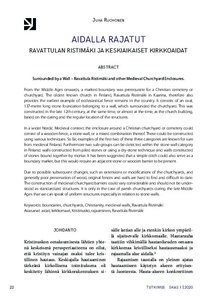Aidalla rajatut. Ravattulan Ristimäki ja keskiaikaiset kirkkoaidat
Juha Ruohonen
https://urn.fi/URN:NBN:fi-fe2022081155010
Tiivistelmä
From the Middle Ages onwards, a marked boundary was prerequisite for a Christian cemetery or
churchyard. The oldest known church in Finland, Ravattula Ristimäki in Kaarina, therefore also
provides the earliest example of ecclesiastical fence remains in the country. It consists of an oval,
137-metre long stone foundation belonging to a wall, which surrounded the churchyard. This was
constructed in the late 12th century, at the same time, or almost at the time, as the church building,
based on the dating and the regular location of the structures.
In a wider Nordic Medieval context, the enclosure around a Christian churchyard or cemetery could
consist of a wooden fence, a stone wall, or a mixed combination thereof. These could be constructed
using various techniques. So far, examples of the first two of these three categories are known for sure
from medieval Finland. Furthermore two sub-groups can be detected within the stone wall category
in Finland: walls constructed from piled stones or using a dry-stone technique and walls constructed
of stones bound together by mortar. It has been suggested that a simple ditch could also serve as a
boundary marker, but this would require an adjacent stone or wooden barrier to be present.
Due to possible subsequent changes, such as extensions or modifications of the churchyards, and
generally poor preservation of wood, original fences and walls are hard to find and difficult to date.
The construction of medieval churchyard barriers could vary considerable and should not be understood as standardized structures. It is only in the case of parish churchyards during the late Middle
Ages that we can speak of uniform structures especially in relation to stone walls.
Kokoelmat
- Rinnakkaistallenteet [19207]
